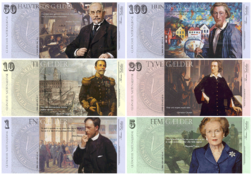Glanish currency: Difference between revisions
(Created page with "{{wip}} {{Infobox currency | currency_name_in_local = | image_1 = File:Glanodel-Currency.png | image_title_1 = Glanish gilder (gælder) | image_2 = | image_title_2 = | iso_...") |
No edit summary |
||
| Line 31: | Line 31: | ||
==History== | ==History== | ||
===Before 1802=== | <!--===Before 1802=== | ||
By the end of the 18th century there were 34 entities minting coins for circulation, including all original 31 cantons as well as the cities of Brosta, Dysted, and Horne, resulting in over 150 different coins in circulation each with varying values, denominations, and monetary systems. | By the end of the 18th century there were 34 entities minting coins for circulation, including all original 31 cantons as well as the cities of Brosta, Dysted, and Horne, resulting in over 150 different coins in circulation each with varying values, denominations, and monetary systems. | ||
| Line 52: | Line 52: | ||
Following the dissolution of the United Kingdom of Lhedwin and its Treasury, the krona became valueless. As a result, one of the first challenges of the provisional government of Glanodel was to reestablish a modern, post-war economy. Granted the authority to regulate commerce by the newly ratified constitution, the new government passed the Single Currency Act granting the federal government sole authority to print the currency authorized as legal tender within the Commonwealth of Glanodel. This was the beginning of the modern gælder. | Following the dissolution of the United Kingdom of Lhedwin and its Treasury, the krona became valueless. As a result, one of the first challenges of the provisional government of Glanodel was to reestablish a modern, post-war economy. Granted the authority to regulate commerce by the newly ratified constitution, the new government passed the Single Currency Act granting the federal government sole authority to print the currency authorized as legal tender within the Commonwealth of Glanodel. This was the beginning of the modern gælder. | ||
At the time it was first issued, the gælder was valued at approximately {{wp|gold standard|0.201536 grams of gold}} and could be redeemed at the federal treasury on demand for its value in {{wp|gold coins}}. In 1956, a referendum and a successive vote by Congress ended the use of the gold standard in Glanodel and the introduction of a {{wp|fiat currency}}. | At the time it was first issued, the gælder was valued at approximately {{wp|gold standard|0.201536 grams of gold}} and could be redeemed at the federal treasury on demand for its value in {{wp|gold coins}}. In 1956, a referendum and a successive vote by Congress ended the use of the gold standard in Glanodel and the introduction of a {{wp|fiat currency}}.--> | ||
Latest revision as of 21:45, 16 October 2022
This article is incomplete because it is pending further input from participants, or it is a work-in-progress by one author. Please comment on this article's talk page to share your input, comments and questions. Note: To contribute to this article, you may need to seek help from the author(s) of this page. |
| Glanish currency | |
|---|---|
 Glanish gilder (gælder) | |
| ISO 4217 | |
| Code | SGG |
| Denominations | |
| Subunit | |
| 1/100 | øre |
| Plural | gilder |
| øre | øre |
| Symbol | ₲ |
| Banknotes | ₲1, ₲5, ₲10, ₲20, ₲50, ₲100, ₲500, ₲1000, ₲5000 |
| Coins | 10c, 25c, 50c (₲ 1⁄10, ₲ 1⁄4, ₲ 1⁄2) |
| Demographics | |
| User(s) | |
| Issuance | |
| Central bank | National Reserve Bank of Glanodel (Vænholms Bank) |
| Valuation | |
| Inflation | 0.7% |
| Source | November 2017 |
The gilder (or gælder in Lhedwinic; Glanish pronunciation: [GILL-DER]; plural: gælder; sign: ₲; code: SGG) is the currency of Glanodel. It is subdivided into 100 øre (singular: øre). The smallest denomination currently produced is the 10 øre coin (or 10 cent coin), but the øre remains the smallest unit of account. The word gælder is based on the Old Lhedwinic word (spelled and pronounced the same) which directly translated to "debt" or "to owe" and was chosen by the majority of Glanish banks to refer to the first banknotes produced in Glanodel.
The gilder is traded globally and has historically been a reliable and consistent store of value. This is generally attributed to its reliable purchasing power, steady and low inflation rate, the political and financial stability of Glanodel, and the central bank's consistent and investor-friendly monetary policies. As a result, the gilder is often described by financial news as a hard currency. In October of 2017, the gilder was the 5th most traded currency in the world by value and accounted for 2.6% of the world's non-gold foreign exchange reserves.